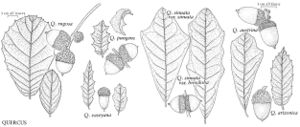Difference between revisions of "Quercus arizonica"
Gard. & Forest 8: 92. 1895.
FNA>Volume Importer |
imported>Volume Importer |
||
| (One intermediate revision by the same user not shown) | |||
| Line 59: | Line 59: | ||
|publication year=1895 | |publication year=1895 | ||
|special status=Illustrated | |special status=Illustrated | ||
| − | |source xml=https:// | + | |source xml=https://bitbucket.org/aafc-mbb/fna-data-curation/src/2e0870ddd59836b60bcf96646a41e87ea5a5943a/coarse_grained_fna_xml/V3/V3_111.xml |
|genus=Quercus | |genus=Quercus | ||
|section=Quercus sect. Quercus | |section=Quercus sect. Quercus | ||
Latest revision as of 21:46, 5 November 2020
Trees, evergreen or subevergreen, small to moderate-sized trees, rarely to 18 m. Bark scaly. Twigs yellowish, 1.5-2.5 mm diam., persistently felty-tomentose, eventually dingy gray. Buds dull russet-brown, ovoid, distally subacute or rounded, 3 mm, sparsely pubescent or glabrate. Leaves: petiole to 3-10 mm. Leaf blade elliptic or oblong to narrowly obovate or oblanceolate, planar or moderately convex, to (30-)40-80(-90) × 15-30 mm, thick and leathery, usually stiff, base cordate or rounded and weakly cordate, margins entire or coarsely toothed especially near apex, cartilaginously revolute, teeth mucronate-tipped, obscure or prominent, secondary veins ca. 7-11 on each side, branching, passing into teeth when present, apex acute to usually obtuse or broadly rounded; surfaces abaxially dull, sparsely pubescent or subtomentose with curly branched hairs, reticulate from prominent, raised secondary veins, usually glaucous where exposed, adaxially dark or bluish green, moderately lustrous, sparsely and minutely stellate-pubescent, secondary veins slightly raised or prominent within depressions or impressed. Acorns solitary or paired, subsessile, occasionally on peduncle to 15 mm; cup hemispheric or cup-shaped, 5-10(-15) mm deep × 10-15 mm wide, enclosing ca. 1/2 nut, base rounded, margin rather coarse, scales cream to brown, broadly ovate, evenly and strongly tuberculate, tomentose, tips closely appressed; nut light brown, ovoid or oblong, 8-12 mm, nearly glabrous. Cotyledons connate.
Phenology: Flowering spring.
Habitat: Oak and pinyon woodlands, margins of chaparral, arroyos
Elevation: 1300-2500(-3000) m
Distribution

Ariz., N.Mex., Tex., Mexico (Chihuahua, Coahuila, Durango, and Sonora).
Discussion
Some of the specimens previously referred to Quercus endemica by C. H. Muller belong here instead.
Putative hybrids between Quercus arizonica and Q. grisea (= Q. ×organensis Trelease) are problematic in local areas of contact from southeastern Arizona to western Texas. These intermediates tend to have narrower leaves than Q. arizonica, with moderately reticulate patterns of venation, and more densely hairy leaves. Quercus arizonica and Q. grisea are amply distinct elsewhere, including large areas in northern Mexico, and they appear to be more closely related to other species than to one another (e.g., Q. arizonica with Q. oblongifolia and Q. laeta Liebmann, and Q. grisea with Q. mohriana and Q. microphylla Née). Thus, Q. arizonica and Q. grisea are best treated as distinct species that hybridize, and not as conspecific populations.
